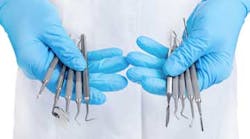When infection control procedures are not followed, there is a risk that infections such as hepatitis B, hepatitis C, and HIV can be transmitted. The 2003 Centers for Disease Control (CDC) Guidelines provide evidence-based infection control practices relevant to the dental industry. The American Dental Association urges all dental practices to employ these infection control procedures and guidelines to prevent infections and reduce the risk of disease transmission.
ADDITIONAL READING |Infection Control Q and A: Instrument processing
Sterilization
Disinfection and sterilization are essential for ensuring that medical and surgical instruments do not transmit infectious pathogens to patients. The federal guidelines for infection control and sterilization specify that weekly spore tests should be performed and the results filed. Understanding and implementing these sterilization methods, in addition to consistent monitoring, helps to ensure effective sterilization, patient safety, and cost-effectiveness. These standards should apply regardless of whether the patient is in an acute-care hospital, ambulatory surgical center, outpatient facility, dental office, or physician’s office.
Classifications for dental instruments
According to the CDC, dental instruments are classified into three categories depending upon the level of risk for infection transmission. Each category includes very specific sterilization guidelines detailed in the CDC guidelines for infection control. The classifications are critical, semi-critical, and noncritical, which are based on the following criteria:
- Critical instruments: instruments used to penetrate bone, soft tissue, and that have contact with the bloodstream or sterile tissue.
- Semi-critical instruments: instruments that contact mucous membranes such as mirrors, reusable impression trays, and amalgam condensers.
- Noncritical instruments: instruments such as x-ray heads, blood pressure cuffs, and pulse oximeters that come into contact with intact skin.
Monitoring sterilization procedures
Sterilization procedures should be monitored through a combination of mechanical, chemical, and biological techniques:
- Mechanical: techniques include assessing the cycle time, temperature, and pressure of sterilization equipment.
- Chemical: indicators use sensitive chemicals to assess physical conditions, such as temperature, during the sterilization process.
- Biological: indicators (BIs) determine whether the most resistant microorganisms are present.
Spore testing
According to the CDC and ADA, spore testing should be performed at least weekly. Proper functioning of cycles should be verified for each sterilizer. In addition to weekly testing, equipment users should also perform biological monitoring after the following:
- When a new type of packaging material or tray is used
- Following the training of new sterilization personnel
- After a sterilizer has been repaired
- Following any change in the sterilizer loading procedures
Common factors that can influence the effectiveness of sterilization:
- Improper cleaning of instruments
- Incorrect or improper packaging
- Improper loading or operating of sterilizer
- Improper timing and temperature
ADDITIONAL READING |Avoid becoming a headline: Federal health advisory recommends review of infection control practices
What if a spore test result is positive?
According to the CDC, if the mechanical and chemical indicators show that the sterilizer is working correctly, a positive spore test may not mean a sterilizer malfunction. Only implantable items should be recalled, and operators should repeat the spore test using the same cycle. The sterilizer should be removed from service and operating procedures reviewed to determine whether operator error could be responsible.
If the repeat result is negative, then the sterilizer can be returned to service. If the repeat result is positive, do not use the sterilizer until it has been inspected or repaired. All results of biological and sterilization monitoring reports should be recorded.







